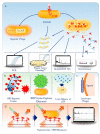The State of the Art in Biodefense Related Bacterial Pathogen Detection Using Bacteriophages: How It Started and How It's Going
- PMID: 33291831
- PMCID: PMC7762055
- DOI: 10.3390/v12121393
The State of the Art in Biodefense Related Bacterial Pathogen Detection Using Bacteriophages: How It Started and How It's Going
Abstract
Accurate pathogen detection and diagnosis is paramount in clinical success of treating patients. There are two general paradigms in pathogen detection: molecular and immuno-based, and phage-based detection is a third emerging paradigm due to its sensitivity and selectivity. Molecular detection methods look for genetic material specific for a given pathogen in a sample usually by polymerase chain reaction (PCR). Immuno-methods look at the pathogen components (antigens) by antibodies raised against that pathogen specific antigens. There are different variations and products based on these two paradigms with advantages and disadvantages. The third paradigm at least for bacterial pathogen detection entails bacteriophages specific for a given bacterium. Sensitivity and specificity are the two key parameters in any pathogen detection system. By their very nature, bacteriophages afford the best sensitivity for bacterial detection. Bacteria and bacteriophages form the predator-prey pair in the evolutionary arms race and has coevolved over time to acquire the exquisite specificity of the pair, in some instances at the strain level. This specificity has been exploited for diagnostic purposes of various pathogens of concern in clinical and other settings. Many recent reviews focus on phage-based detection and sensor technologies. In this review, we focus on a very special group of pathogens that are of concern in biodefense because of their potential misuse in bioterrorism and their extremely virulent nature and as such fall under the Centers for Disease and Prevention (CDC) Category A pathogen list. We describe the currently available phage methods that are based on the usual modalities of detection from culture, to molecular and immuno- and fluorescent methods. We further highlight the gaps and the needs for more modern technologies and sensors drawing from technologies existing for detection and surveillance of other pathogens of clinical relevance.
Keywords: bacteriophage; bioterrorism; biothreat; diagnostics; phage detection.
Conflict of interest statement
The authors declare no conflict of interest.
Figures

Similar articles
-
Bacteriophage-based bioassays: an expected paradigm shift in microbial diagnostics.Future Microbiol. 2024 Jun 12;19(9):811-824. doi: 10.2217/fmb-2023-0246. Epub 2024 Jun 20. Future Microbiol. 2024. PMID: 38900594 Free PMC article. Review.
-
Phage-Mediated Molecular Detection (PMMD): A Novel Rapid Method for Phage-Specific Bacterial Detection.Viruses. 2020 Apr 11;12(4):435. doi: 10.3390/v12040435. Viruses. 2020. PMID: 32290520 Free PMC article.
-
Pathogen detection using engineered bacteriophages.Anal Bioanal Chem. 2012 Apr;402(10):3127-46. doi: 10.1007/s00216-011-5555-5. Epub 2011 Nov 20. Anal Bioanal Chem. 2012. PMID: 22101465 Review.
-
From Bits and Pieces to Whole Phage to Nanomachines: Pathogen Detection Using Bacteriophages.Annu Rev Food Sci Technol. 2017 Feb 28;8:305-329. doi: 10.1146/annurev-food-041715-033235. Epub 2017 Jan 11. Annu Rev Food Sci Technol. 2017. PMID: 28125341 Review.
-
Bacteriophage-based pathogen detection.Adv Biochem Eng Biotechnol. 2010;118:65-83. doi: 10.1007/10_2009_7. Adv Biochem Eng Biotechnol. 2010. PMID: 19475368 Review.
Cited by
-
Reuse, Repurpose, and Recycle: Bacteriophages and Microbial Surveillance (1921-2023).Phage (New Rochelle). 2024 Mar 18;5(1):14-21. doi: 10.1089/phage.2023.0042. eCollection 2024 Mar. Phage (New Rochelle). 2024. PMID: 40114808 Free PMC article. Review.
-
Phage therapy: From biological mechanisms to future directions.Cell. 2023 Jan 5;186(1):17-31. doi: 10.1016/j.cell.2022.11.017. Cell. 2023. PMID: 36608652 Free PMC article. Review.
-
A systematic review of sensors to combat crime and routes to further sensor development.Front Chem. 2025 Jun 12;13:1568867. doi: 10.3389/fchem.2025.1568867. eCollection 2025. Front Chem. 2025. PMID: 40575464 Free PMC article. Review.
-
Reporter-Phage-Based Detection and Antibiotic Susceptibility Testing of Yersinia pestis for a Rapid Plague Outbreak Response.Microorganisms. 2021 Jun 11;9(6):1278. doi: 10.3390/microorganisms9061278. Microorganisms. 2021. PMID: 34208306 Free PMC article.
References
Publication types
MeSH terms
Substances
LinkOut - more resources
Full Text Sources
Medical

